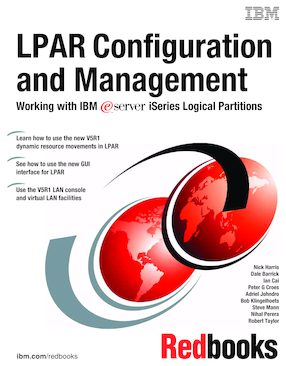LPAR Configuration and Management Working with IBM eServer iSeries Logical Partitions
An IBM Redbooks publication
Note: This is publication is now archived. For reference only.

Published on 17 April 2002
ISBN-10: 073842188X
ISBN-13: 9780738421889
IBM Form #: SG24-6251-00
Authors: Nick Harris, Dale Barrick, Ian Cai, Peter G Croes, Adriel Johndro, Bob Klingelhoets, Steve Mann, Nihal Perera and Robert Taylor
Since its introduction with OS/400 V4R4 in 1999, logical partitioning (LPAR) has re-energized server consolidation strategies both for IBM eServer iSeries and AS/400 customers. It continues to take full advantage of the innovative hardware and software technologies that are made available with the iSeries and OS/400 V5R1.
Customers that have successfully implemented LPAR with OS/400 V4R4 and V4R5 have also awaited the enhancements to perform resource movement without requiring an Initial Program Load (IPL). OS/400 V5R1 provides this ability. It allows dynamic movement of resources such as CPU, memory, and interactive performance. V5R1 also extends LPAR support to the new iSeries Model 270 SStar processor features, including the ability to partition a uniprocessor to support both OS/400 V5R1 and Linux partitions.
OS/400 V5R1 with iSeries provides an environment to optimize IT hardware infrastructure through server consolidation and LPAR. This is made possible with the combined support for High Speed Links (HSL), independent auxiliary storage pools (IASP), Integrated xSeries Adapters, fibre channel support for Enterprise Storage Server (ESS), and high speed disk and LAN adapters.
This IBM Redbooks publication is intended to help you with V5R1 LPAR planning and implementing considerations. It looks at various scenarios that implement LPAR. This book complements the LPAR information provided in the iSeries Information Center. Plus, it includes additional practical scenarios for implementing LPAR with OS/400 V5R1.
Chapter 1. Logical partitioning concepts
Chapter 2. Understanding logical partitioning
Chapter 3. Planning for logical partitions
Chapter 4. Logical partition setup
Chapter 5. Migrating logical partitions
Chapter 6. Operating LPAR environments
Chapter 7. LAN console
Chapter 8. Dynamic resource management
Chapter 9. Logical partition problem management
Chapter 10. Interpartition communications
Chapter 11. Configuring Linux in a guest partition
Chapter 12. Basics of using the LPAR Validation Tool (LVT)
Appendix A. LPAR planning worksheets
Appendix B. System reference codes (SRCs) and messages
Appendix C. Sample code
Appendix D. Additional material